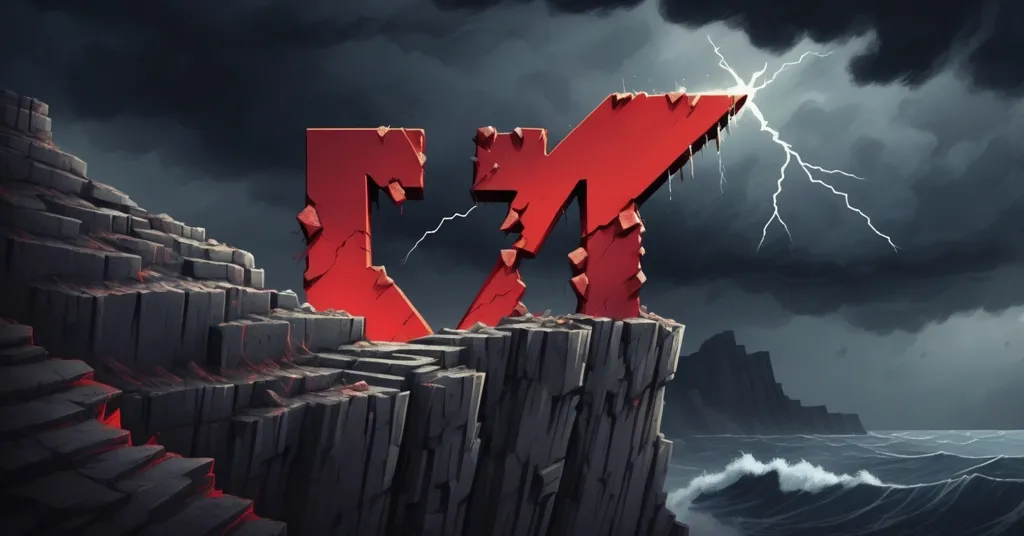XRP Plummets 16%: Is This the Start of a Crypto Bear Market?

XRP’s Price Crash Sparks Fear: Bear Market Looming for Crypto?
XRP is in freefall, plummeting 16% in a single week and hovering dangerously near the critical $2 support level, as panic sweeps through the crypto market. With the Fear and Greed Index sinking to a chilling 15, signaling widespread investor dread, the question looms large: is this brutal sell-off a sign of XRP’s collapse, or the first tremor of a broader bear market for digital assets?
- XRP’s Steep Decline: A 16% price drop in one week, teetering at the $2 mark.
- Market Anxiety: Fear and Greed Index at 15, a low not seen since April.
- Downside Risks: Potential drops to $1.75 or $1.47 if support fails.
- Bigger Picture: Could XRP’s fall signal a crypto-wide downturn?
XRP’s Price Plunge: Unpacking the Carnage
The numbers are stark, and they’re not pretty. XRP, the token associated with Ripple Labs, has shed 16% of its value in just seven days, with its price flirting with the pivotal $2 threshold. Trading volume over the past 24 hours has spiked by 27%, representing nearly 5% of its circulating market cap—a clear indicator of mass selling or desperate attempts to buy the dip. For perspective, that surge in volume reflects billions of dollars changing hands, a frenzy that’s often a precursor to even wilder swings. This isn’t just a hiccup; it’s a glaring warning sign that XRP is under severe pressure.
For those new to crypto, let’s break down a key metric fueling this unease: the Fear and Greed Index. Think of it as a thermometer for market mood—ranging from 0 (absolute terror) to 100 (reckless optimism). A reading of 15, a level untouched since April, means investors are practically hiding under their beds. It’s a signal of extreme fear, often driven by uncertainty, bad news, or broader economic jitters. And right now, XRP is bearing the brunt of this collective anxiety, with its market cap shrinking and sentiment souring fast.
Market Sentiment: Fear Takes Hold
XRP’s woes aren’t an isolated incident; they’re part of a wider wave of dread washing over the crypto space. Beyond the Fear and Greed Index’s dismal score, open interest in XRP futures—essentially the total money tied up in bets on its future price—has slumped to its lowest since November. Back then, a fleeting burst of optimism tied to Donald Trump’s electoral momentum briefly lifted crypto spirits. No such luck now. The absence of positive catalysts, coupled with macroeconomic headwinds like rising interest rates and persistent inflation, is spooking investors across the board.
Compare this to other major players like Bitcoin and Ethereum, which, while not unscathed, often hold up better during turbulence. Bitcoin, frequently dubbed digital gold, benefits from its perception as a store of value, attracting cautious capital in rough times. Ethereum, with its sprawling ecosystem of decentralized apps, has a utility buffer. XRP, however, lacks that same defensive moat, making it a prime target for panic selling. Could its downfall pull other altcoins into the abyss, or is this a selective purge of weaker assets? It’s a question worth chewing on as the market teeters.
XRP ETF Launch: A Lifeline That Flopped
Amid this chaos, a glimmer of hope emerged with the launch of a new XRP exchange-traded fund (ETF) in the United States—a product designed to let traditional investors track XRP’s price without owning the token directly. Think of it as buying a stock that mirrors gold’s value without holding the metal yourself. ETFs are often hailed as bridges to mainstream adoption, lending crypto a sheen of legitimacy in the eyes of Wall Street. So, you’d expect this to spark some excitement for XRP, right? Not a chance.
The ETF debut has failed spectacularly to halt XRP’s slide, overshadowed by the market’s pervasive gloom. Even this milestone, a nod to crypto’s growing integration with conventional finance, couldn’t muster buying interest. Contrast this with Bitcoin’s ETF launches in recent years, which, while not always immediate game-changers, often fueled long-term bullish sentiment. For XRP, the timing couldn’t be worse—or perhaps it reveals deeper skepticism about its fundamentals. Whatever the case, this supposed knight in shining armor showed up without a horse.
Technical Outlook: Where Is XRP Headed?
Let’s get into the nitty-gritty of the charts, because they’re flashing some ominous signals. XRP is clinging to a key trend line support around $2—a price level where buyers have historically stepped in to prevent further drops. If this barrier cracks, and the momentum suggests it might, analysts point to downside targets of $1.75 (a 17% tumble from current levels) or even $1.47 (a punishing 30% nosedive). That’s not just a haircut; it’s a full-on scalping for holders already reeling from the recent losses. For deeper insights into the potential collapse, check out this analysis on XRP’s brutal sell-off.
For the uninitiated, trend line support is like a psychological floor in the market—break it, and sellers often gain the upper hand, driving prices lower. On the flip side, there’s a sliver of hope: some technical indicators, like potential oversold conditions on the Relative Strength Index (RSI), hint that a bounce could happen if panic selling exhausts itself. But let’s not sugarcoat it—the bearish outlook dominates for now, and betting on a quick recovery is more wishful thinking than sound strategy.
XRP’s Unique Struggles: Centralization and Legal Shadows
XRP’s current predicament isn’t just about market dynamics; it’s also tied to its own baggage. Unlike Bitcoin, which prides itself on decentralization with no central authority calling the shots, XRP is closely linked to Ripple Labs, a company that controls a significant chunk of the token supply. This centralization rubs many crypto purists the wrong way, clashing with the ethos of freedom and privacy we champion. Why trust a system that feels more like a corporate project than a grassroots revolution?
On top of that, Ripple’s long-running legal battle with the U.S. Securities and Exchange Commission (SEC) over whether XRP is an unregistered security continues to cast a shadow. Though not the direct trigger for this week’s crash, the uncertainty weighs on investor confidence, making XRP a riskier bet compared to battle-tested assets like Bitcoin. Historically, XRP has weathered brutal downturns—think the 2018 bear market, where it lost over 80% of its value. Today’s drop isn’t quite that catastrophic yet, but the echoes of past pain are hard to ignore.
Bear Market or Temporary Correction?
So, is XRP’s crash the canary in the coal mine for a full-blown crypto bear market? It’s tempting to sound the alarm with sentiment this sour, but let’s pump the brakes and consider the broader landscape. Bitcoin, while wobbly, hasn’t collapsed to the same degree, and Ethereum’s price action shows more resilience tied to its staking yields and DeFi ecosystem. Past bear markets, like 2018 or 2022, saw synchronized drops across nearly all assets, often sparked by systemic shocks—think regulatory crackdowns or bursting bubbles. We’re not quite there yet.
Playing devil’s advocate, XRP’s fall could simply be a long-overdue correction for an asset that’s often overpromised and underdelivered. Altcoin volatility tends to spike during cycles of Bitcoin dominance, where capital flows back to the king of crypto, leaving tokens like XRP exposed. Plus, institutional adoption—however sluggish via ETFs—might still lay groundwork for stability down the road. Then again, with macroeconomic pressures like global market sell-offs piling on, dismissing the bear market theory outright feels naive. The jury’s still out, but the claws are definitely showing.
Risky Detours: Maxi Doge and Meme Coin Madness
As XRP holders nurse their wounds, some are pivoting to speculative plays like Maxi Doge ($MAXI), a meme coin hyping itself as a trader-focused community with competitions and presale buzz. Up to 25% of its presale funds will reportedly be invested in major tokens, with profits earmarked for marketing. It’s a high-octane gamble, compatible with platforms like Best Wallet, aimed squarely at risk-takers. But let’s be real—meme coins are the crypto equivalent of lottery tickets. Fun with spare change, sure, but don’t bet your future on them. They thrive on hype, not fundamentals, and most fizzle out faster than a cheap firework.
Scammers and Shillers: Don’t Fall for the Trap
One final rant before we wrap up: beware the vultures circling during downturns like this. Fake recovery services, pump-and-dump Telegram groups, and self-proclaimed “gurus” promising XRP will “10x by next week” are out in full force. It’s all garbage. No one can predict prices with certainty, and anyone claiming otherwise is either delusional or trying to fleece you. We’re here to push adoption through hard truths, not fairy tales. If it sounds too good to be true in crypto, it damn well is. Protect your wallet and your sanity—stick to verifiable info and tune out the noise.
Key Takeaways and Critical Questions
- What’s driving XRP’s 16% price crash?
A toxic mix of a broader crypto market downturn and extreme investor fear, reflected in the Fear and Greed Index hitting a low of 15, is battering XRP’s value. - Could XRP slide even lower, and to what levels?
If the $2 support level breaks, XRP risks falling to $1.75 (a 17% drop) or as low as $1.47 (a 30% plunge), based on current technical trends. - Why didn’t the new US XRP ETF stop the decline?
Despite its potential to boost mainstream adoption, the ETF launch was drowned out by market-wide panic and relentless selling pressure. - Does this signal a crypto bear market?
XRP’s struggles and weak market indicators like low futures interest suggest serious trouble, but it’s premature to confirm a full bear market across all crypto assets. - How do XRP’s centralization and legal issues play into this?
Ties to Ripple Labs and an ongoing SEC lawsuit fuel uncertainty, making XRP more vulnerable than decentralized giants like Bitcoin during downturns. - Are speculative plays like Maxi Doge ($MAXI) a viable alternative?
While $MAXI offers presale hype and community focus, meme coins are extremely risky, often driven by speculation rather than real value. - Why should Bitcoin remain the safer bet?
As a proven store of value with unmatched decentralization, Bitcoin typically weathers storms better than altcoins like XRP, aligning with core crypto principles of freedom.
Crypto is a wild ride, and XRP’s current beating reminds us that the path to financial revolution is paved with pitfalls. Yet, beneath the volatility, the promise of decentralization, privacy, and disruption burns bright. We’re rooting for Bitcoin to lead the charge as the ultimate bastion of freedom, while recognizing that altcoins like XRP carve out their own niches—risky as they may be. Stay sharp, ignore the scammers, and keep your eyes on the long game. We’ll keep slicing through the hype to bring you the unvarnished truth about where this space is headed next.



